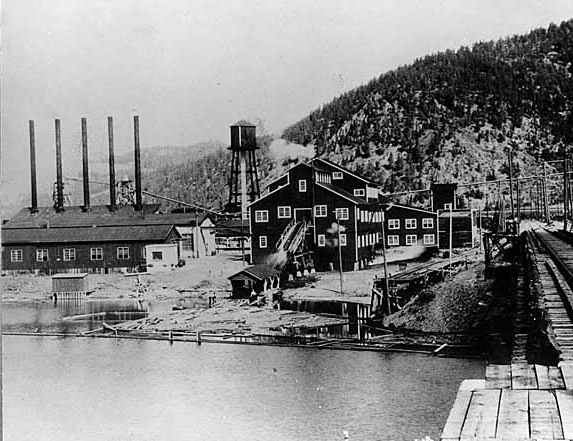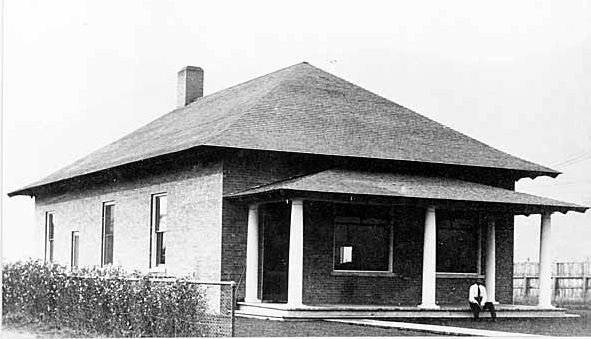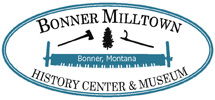 Western Mill 1915 With his mining enterprise well-established, William Clark turned to the Bonner area, where he focused on the perceived unlimited timber resources of this region. Square stulls which held up the mine shafts were in constant demand. In 1898 Clark established the Western Lumber Company with Judge W. M. Bickford, A. H. Wethey (Clark’s business manager from Butte), Alex Johnson, and H. W. McLaughlin, a legislator whose support Clark was trying to obtain.
Western Mill 1915 With his mining enterprise well-established, William Clark turned to the Bonner area, where he focused on the perceived unlimited timber resources of this region. Square stulls which held up the mine shafts were in constant demand. In 1898 Clark established the Western Lumber Company with Judge W. M. Bickford, A. H. Wethey (Clark’s business manager from Butte), Alex Johnson, and H. W. McLaughlin, a legislator whose support Clark was trying to obtain.
The Company bought McLaughlin’s planning mill in Missoula, all his timberlands, and his small mill on Nine Mile Creek, just west of Missoula, for the “extravagant” amount of $24,684. Clark turned the old McLaughlin planning mill into the Western Montana Flouring Mill in direct competition with Anaconda’s existing flour mill in Bonner. In 1904, Anaconda's mill burned and was not rebuilt, but Clark’s mill remained long after.
Western Lumber operated the sawmill at Nine Mile for one and a half years. In 1900, the Company began construction of a new, larger sawmill at Lothrup at the mouth of Petty Creek, where it would have easy access to the Northern Pacific Railroad. The Company acquired 15,000 acres by trading inholdings within the adjacent US Government Forest Reserve for land closer to the mill. Clark also bought or traded for extensive timber holdings in the Blackfoot River region, in anticipation of the time when timber supplies around Lothrup would be depleted.
Clark then built a lumber mill within a half mile of the existing Anaconda mill in Bonner. As a first step, in 1904, Clark-Montana Realty (Clark's realty division) bought most of John McCormick’s land on the Missoula River (Clark Fork) for leased housing for his future mill workers. In the interim Clark-Montana Realty leased the land to Anaconda mill workers, who build their own homes on the leased land. This would become the community of Milltown.
Shortly thereafter, Western's manager, C. H. Richardson, sited Clark’s dam in Milltown to power the new permanent sawmill. The dam, completed in late 1907, was located on the Missoula River (Clark Fork River) near its confluence with the Big Blackfoot River. Clark had bought Missoula Light and Power from the Hammond interests in 1906, assuring control of users of the power from his dam. He was putting his electricity monopoly in place.
The sawmill was the last of Clark’s enterprises to be built in the Missoula area. The mill, physically moved from Lothrup on the Northern Pacific (NP) Railroad between 1911 and 1912 meant that for a short period Bonner-Milltown became a two mill community. The new mill was modern and run by electricity. In contrast to the Lothrup mill which had a daily capacity of 100,000 bf every 10 hour shift, the Western, as it was called, could produce 130,000 bf daily. The Western Lumber Office is all
The Western Lumber Office is all
that remains of the mill. Some 200 men were on the payroll in addition to loggers. Many of these had come from Lothrup. The common laborer earned $0.42/hr or $3.36 a day. Unlike Anaconda, the Western did not provide houses for their management. C. H. Richardson, manager of the Western, bought one of the first lots in West Riverside and built his home there. Many of the workers lived in Milltown in houses leased to them by Clark-Montana Realty. Charles Hart who owned the Riverside Grocery collected the rents for Clark.
Clark’s son, William Andrews Clark Jr. was president of the company and frequently seen on the mill site. The Western contracted for all its logs and had them delivered by rail. For example, Joe Moderie shipped logs from the Flathead Valley to the mill. Another contractor named Hill brought logs from Deer Creek in 1916. The logs were dumped in the Clark Fork and floated to the mill.
Clark made use of both the Northern Pacific and the Chicago, Milwaukee and St Paul Railroads to bring in logs and take out lumber. Logs arriving at the mill by rail were taken to the mill by an electric engine called a dinky engine. Sparks from steam engines caused frequent fires, so this engine reduced the fire hazard. After the Northern Pacific moved to the double track line in 1908, the dinky engines were operated on the site of the old line, which became the street car track. A spur line from the main track took the engine on the west side of the Blackfoot so the logs could be dumped in the river into the “hot ponds,” areas which were kept ice free.
Much of the lumber from the mill initially went to Butte. Later lumber was shipped to Chicago as well as markets in Kansas City, St. Louis and New York, with occasional shipments to Boston. Electric locomotives also delivered lumber to Clark’s retail store in Missoula. At Clark’s death there was a surplus of logs at both his mill and the Anaconda mill.
The Anaconda Company bought the mill from Clark’s heirs in 1928 and continued to operate both mills for several years. The Depression and the difficulty of running two adjacent mills caused Anaconda to close the Western in 1931. It took a couple of years for the mill to be dismantled and the inventory used up. Fifty men were still employed at the Western in 1932, but none the next year.
